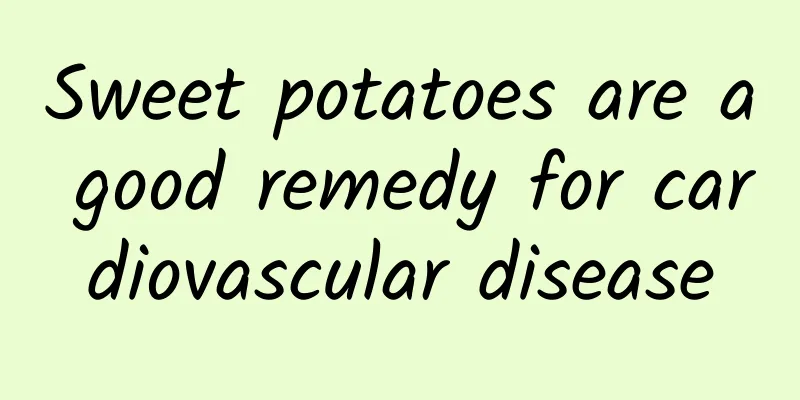Sweet potatoes are a good remedy for cardiovascular disease

|
Author: Huang Yanhong Duan Yuechu In the pursuit of cardiovascular health, diet plays a vital role. Among them, sweet potatoes, as a common and unique food, play an important role in cardiovascular health. The benefits of sweet potatoes for cardiovascular health stem from their many characteristics. First, the glycemic index of sweet potatoes is low, which means that after entering the human body, it will not cause drastic fluctuations in blood sugar after a meal. We can imagine the human body as a complex and sophisticated machine, and blood sugar is one of the fuels that keeps it running, but large fluctuations in blood sugar are like a sudden strong shock when the machine is running, which can cause damage to the cardiovascular system. Stable blood sugar levels are essential for cardiovascular health, because drastic fluctuations in blood sugar increase insulin resistance, which in turn triggers a series of metabolic disorders, like a domino effect, increasing the risk of cardiovascular disease. Long-term high blood sugar levels are like an invader hidden in the dark, which damages vascular endothelial cells, causes thickening and hardening of the blood vessel walls, forms atherosclerotic plaques, and ultimately affects the normal functioning of cardiovascular function. Sweet potatoes are rich in dietary fiber, which is another important reason why they are an "ally" of cardiovascular health. Dietary fiber is like a small cleaning guard in the human intestine. It can promote intestinal peristalsis, speed up the passage of food in the intestine, and reduce the intestinal absorption of harmful substances such as cholesterol. At the same time, dietary fiber can also combine with bile acid, like a close partner, to promote the excretion of bile acid from the body. In order to synthesize new bile acid, the liver consumes more cholesterol, thereby lowering the cholesterol level in the blood. Lower cholesterol levels are like a layer of "protective clothing" for the cardiovascular system, which helps prevent the occurrence and development of atherosclerosis, keep blood vessels unobstructed, and allow blood to flow smoothly in the blood vessels. In addition, sweet potatoes have the characteristics of strong satiety and low calorie density. When we use sweet potatoes as part of the staple food, it is like starting a healthy eating pattern. It can not only reduce the total calorie intake and prevent excess calories from accumulating in the body and causing obesity, but also maintain satiety for a long time, reduce appetite and the number of meals. Obesity and insulin resistance are two important risk factors for cardiovascular disease, and this characteristic of sweet potatoes can help us control our weight and reduce the secretion pressure of insulin, thereby reducing the burden on the heart, improving cardiovascular function, and making blood pressure, blood lipids and other cardiovascular disease-related indicators develop in a healthy direction. However, although sweet potatoes are good, there are some precautions when eating them. The crude fiber in sweet potatoes may be a burden for some people with weak digestive functions, such as the elderly and patients with gastrointestinal diseases. Excessive consumption can easily lead to uncomfortable symptoms such as bloating and diarrhea. Moreover, sweet potatoes contain a certain amount of sugar. Diabetic patients need to be extra cautious when eating them, pay attention to controlling the amount of consumption, and avoid increasing blood sugar. Therefore, the consumption of sweet potatoes should follow the principle of individual differences and moderate balance. For example, sweet potatoes can be eaten with other staple foods, such as mixing with rice, flour, etc. to make food, so that you can enjoy the nutrition brought by sweet potatoes and reduce possible discomfort reactions. In addition to sweet potatoes, there are many other foods that are beneficial to cardiovascular health. Among vegetables, spinach and broccoli are excellent representatives. Spinach is rich in folic acid, potassium and cellulose. Folic acid is like a guardian angel, which can reduce the level of homocysteine in the blood, because too high homocysteine can damage vascular endothelial cells and increase the risk of cardiovascular disease. Potassium is like a silent guard, which is of great significance to maintaining normal heart function and blood pressure stability. Cellulose can promote intestinal peristalsis and reduce cholesterol absorption. Broccoli contains antioxidant ingredients such as sulforaphane. Antioxidants are like a solid shield to fight against free radical damage to blood vessels, reduce inflammatory reactions, and prevent atherosclerosis. Among fruits, blueberries and apples should not be ignored. Blueberries are rich in anthocyanins, a powerful antioxidant that can improve endothelial function, lower blood pressure, reduce the oxidation of cholesterol in the blood, inhibit platelet aggregation, and thus reduce the incidence of cardiovascular disease. Apples are rich in pectin, a water-soluble dietary fiber that can lower cholesterol and regulate blood sugar levels. The potassium in apples also helps maintain stable blood pressure. Oats and brown rice in the whole grain category are also beneficial to cardiovascular health. Oats are rich in β-glucan, which can lower low-density lipoprotein cholesterol ("bad cholesterol") in the blood and reduce the risk of atherosclerosis. At the same time, its dietary fiber can increase satiety, help control weight, and indirectly protect the cardiovascular system. Compared with polished rice, brown rice retains more nutrients, such as dietary fiber and B vitamins. Dietary fiber helps lower cholesterol, and B vitamins participate in the body's metabolism and maintain heart and blood vessel health. Almonds and flaxseeds in the nuts and seeds category also performed well. Almonds contain nutrients such as monounsaturated fatty acids, vitamin E and magnesium. Monounsaturated fatty acids can lower cholesterol, vitamin E is an antioxidant that can protect blood vessel walls, and magnesium helps stabilize heart rhythm. Flaxseeds are rich in α-linolenic acid, which can be converted into EPA (eicosapentaenoic acid) and DHA (docosahexaenoic acid) in the human body, which are beneficial to the cardiovascular system. It has anti-inflammatory and triglyceride-lowering effects, reduces blood viscosity, and reduces the risk of thrombosis. Among fish, salmon and sardines are also good helpers for cardiovascular health. Salmon is a high-quality source of Omega-3 fatty acids, which can reduce triglyceride levels, reduce inflammation, lower blood pressure, reduce the risk of arrhythmia, and have a multi-faceted protective effect on the cardiovascular system. Sardines are also rich in Omega-3 fatty acids, and are rich in nutrients such as protein and calcium, which are helpful for improving blood vessel elasticity and lowering cholesterol. These foods are like a powerful health alliance, each playing a unique role and jointly protecting cardiovascular health. We should choose and match foods reasonably according to our own situation, so that diet can become a powerful weapon for us to maintain cardiovascular health and embrace a healthy and beautiful life. This is not only related to our personal health, but also to the length and quality of the happy time we share with our family. The author Huang Yanhong is the attending physician of Shimashan Health Center in Lianyuan City, Hunan Province Duan Yuechu is a member of the China Future Research Society and a member of the China Science Writers Association |
>>: Freedom in a wheelchair: wheelchair options for people with spinal cord injuries
Recommend
What happens when the areola becomes larger?
The areola is located around the nipple and is an...
Personal experience of induced abortion at 8 months of pregnancy
In daily life, some female friends need to have i...
How much hcg does it mean that there is a fetal heartbeat or embryo
Pregnant women can accurately judge the fertility...
What colors are zebrafish? What foods do zebrafish like to eat?
Zebrafish is commonly known as "striped fish...
What to do if you have vaginal itching during pregnancy
During pregnancy, many diseases will occur due to...
How did Bai Gun Gun come from? In which episode of Three Lives Three Worlds: The Pillow Book did Bai Gun Gun appear?
Speaking of Three Lives, Three Worlds, I believe ...
Such a combination of women can lead to gynecological diseases
As the severe winter approaches, many female frie...
How to treat adhesion of fallopian tube fimbria better
Adhesion of the fallopian tube fimbria is the mos...
What is the normal hcg value for early pregnancy?
The hcg value is a manifestation of abnormality i...
Oral Science I How much do you know about the causes of bad breath?
1. Causes of Bad Breath 1. Not paying attention t...
How to choose black dates? How to store black dates
Black dates are the fruit of the Persimmon family...
Can pregnant women eat lilies?
Lily is a pure and noble flower, symbolizing roma...
The protagonist of "Black Panther" died of colon cancer. How can we prevent colorectal cancer?
Huazi saw a piece of news that Chadwick Boseman, ...
Why do dentists say that it is not recommended to brush your teeth immediately after eating acidic food! ?
1. Can you brush your teeth immediately after eat...









